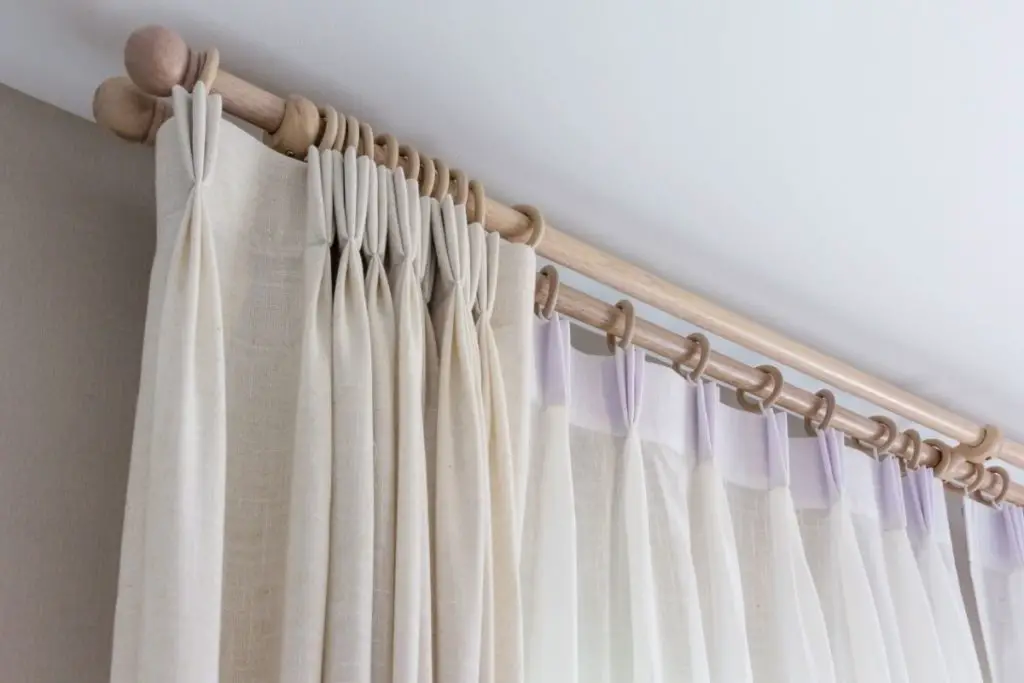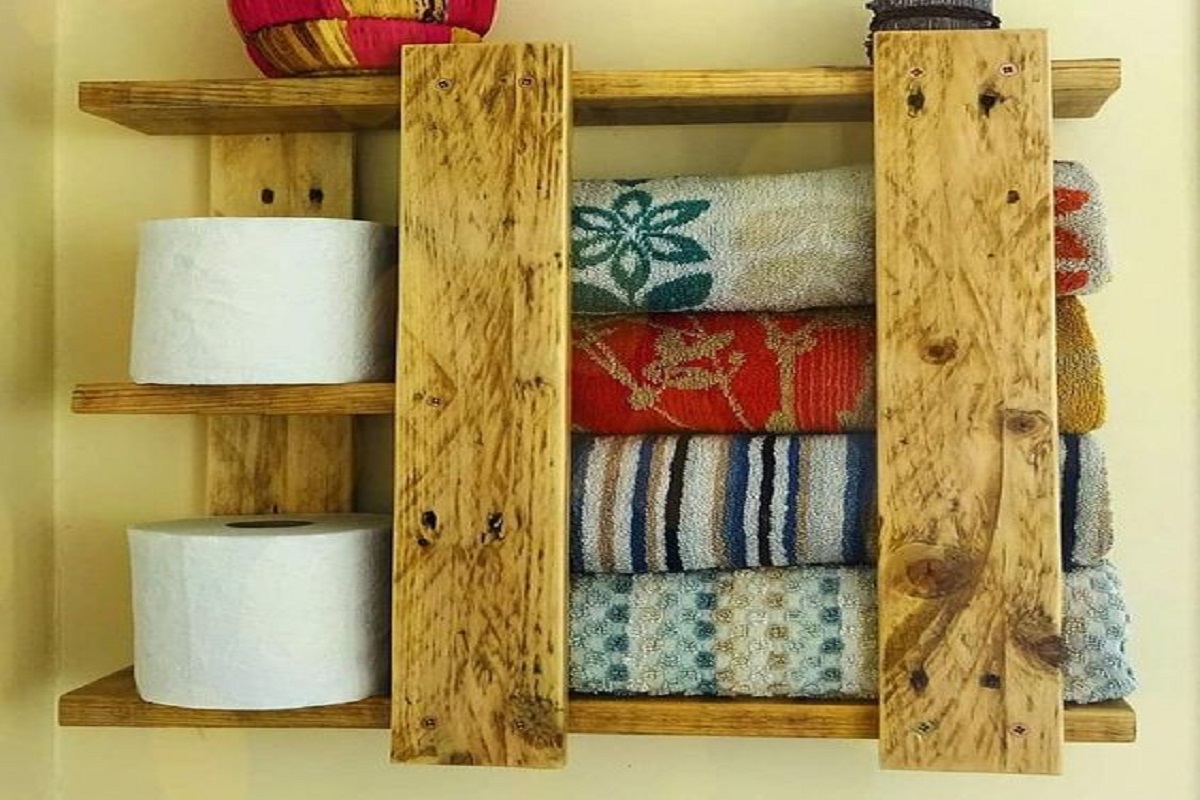Buying the latest addition to your room can be difficult, whether it is curtains, carpets, or pillows. Curtains are certainly some difficult things to get right.

There is nothing worse than ill-fitting curtains, or curtains on a pole too large. Yet, it is not common knowledge about the standard curtain size. So in this article, we are going to shine some light on the standard sizes.
Curtains can come in all shapes, sizes, and colours. They can be low to the floor, or high, just touching below the length of the window.
It is super important to get your curtains right, as there really is nothing worse than a lack of privacy. To help you fit your curtains, we will provide you with a size chart, so you always have well-fitted curtains!
What Is The Standard Curtain Size?
In the US, there is a standard curtain panel width and several standard length sizes. The standard width of curtain panels is 48 inches wide.
The length of these panels comes in four different lengths. They are 63 inches, 84 inches, 96 inches, and 108 inches.
The size and length of your curtain completely depend on the type of window you have, and how close you want it to the floor.
There is also a curtain size chart that we have drafted up for you. This will help you understand the curtain lengths and widths, and how to measure them up.
Length
Curtain lengths usually come in numerous sizes, and these are usually all the same. These are 63 inches, 84 inches, 96 inches, 108 inches, and 120 inches.
It is rare to have curtains that are as short as 63 inches, and it is not as common to have curtains as long as 120 inches. We shall go into some detail about the lengths of curtains, and how to find out.
It is really crucial not to buy curtains that are the same size as your windows. Imagine, curtains hanging down, with a gap at the top, as well as the bottom!
You need curtains that cover your windows, as well as the gap between the window and the curtain rail. You do not want uncovered windows.
Likewise, you may also need to think about the height of your ceiling, and what kind of effect you want the curtains to have in the room.
The minimum measurement that you should have is 6 inches between the bottom of the window and the curtains. This will ensure you have all the privacy that you desire from curtains.
Width
Typically, standard curtain panels are all the same size. It is mostly the length that is different with curtains. Standard curtain widths are usually 48 inches wide.
The real hassle is the curtain length, rather than the widths. The chart below shows how you should find the correct curtain width based on the gather of the curtains.
| Curtain PairPack x Width | Approximate pole length for a full gather | Approximate pole length for relaxed gather |
| 46 inches | 46 inches | 66 inches |
| 66 inches | 66 inches | 90 inches |
| 90 inches | 90 inches | 112 inches |
| 112 inches | 112 inches | 157 inches |
Curtain Panel Styles
There are a few different styles of curtain panels, and these determine how low your curtains will go. We are going to talk about floating curtains, special-length curtains, puddling curtains, and floor kissing curtains.
Most of these curtains are floor touching curtains, but we will also talk about window height curtains later on.
Floating
Floating curtains create an incredibly calming and chill effect in any kind of room. With floating curtains, you can create a lovely wide and panoramic view, and it frames your windows pretty well.
If you want something quite gentle, it may be wise to get floating curtains in a lighter colour, even a sheer colour. You can even add draperies to tie to the wall to get a more elegant look.
Floating curtains typically do not reach the floor, hence why they are called floating curtains. They float between the ceiling and floor, and they sufficiently cover the windows enough to give you privacy, as well as an elegant look for your room.

Floating curtains are most likely to be found in bedrooms rather than sitting rooms, as bedrooms tend to have that more simplistic feel.
In terms of practicality, floating curtains are actually a lot easier to have, and they are easier to clean below and above.
If you have to vacuum, floating curtains do not trail onto the floor, so there is no risk that they will get caught in the vacuum. If you have pets or small children, they will not be able to pull on the curtains.
Floating curtains are simple to maintain and easy to put up. The only things you may need to be wary of is that they can make your ceiling appear low, and they can make the room feel slightly smaller than floor-length curtains.
Special Lengths
Special length curtains are perfect for windows that do not need full coverage. This includes kitchens, dining rooms, and certain sitting rooms or open areas.
Curtains should not have thick or long curtains because it will trap in smells, as well as grease. There are three examples of special length curtains. This includes windowsill curtains, valances, and tier curtains.
Window sill curtains do exactly what they say—they are just the level of your window sill, and they are at this height because large furniture such as kitchen counters or shelves are usually in the way.
Valances are typically around 5 inches long, and only go over the top part of the window, simply blocking out any harsh sun. They are frequently found in old-fashioned houses that are cottage styled.
Tier curtains
Puddling
Puddling length curtains simply overhang, so they resemble a pudding on your floor. They are long, and they are always longer than the size of your window.
They are often made of thicker fabric, often patterned, to create a dramatic appearance. You will find these curtains in wealthy looking homes, in elegant and dark rooms such as the dining room.
They are formal and traditional, with an artistic and elegant feel to them. They are not easy to put up or maintain.
This is why they are often found in older, wealthier homes, rather than homes with lots of children and pets. They are difficult to clean, and they take a lot of maintenance to ensure they are well kept.
Floor Kissing
Floor-kissing curtains are ideal for rooms with high ceilings, or larger rooms where you want to add a bit of elegance. Floor kissing curtains are longer curtains that kiss the floor, but they are not overflowing on the floor.
When buying floor kissing curtains, you should look to buy a slightly larger size than you need, and shorten them if necessary.
It is better to buy slightly longer curtains than buying floor kissing curtains that are inches off the floor. It can be difficult to measure and shorten the curtains yourself, so it may be worth investing in custom made floor kissing curtains.
Why It Is Important To Get The Correct Curtain Size And Look
Curtains can completely change the appearance of a room and give each room a facelift. It is incredibly important to choose curtains that fit the windows and will fit the appearance of your room.
Curtains can also successfully hide parts of your room that you do not like. Make sure you measure the window before buying, so you know for definite that the curtains will fit.
A disappointment in the choice of curtains can be caused by the wrong colour, fabric, or length.
How To Measure For The Correct Curtain Length
When measuring for your curtains, make sure to measure from the floor upwards. This will ensure that your curtains will not be dramatically short, as there is nothing worse than short curtains. Make sure to measure using a reliable and good measuring tape.
Additionally, make sure your curtain pole is at least 4 inches up from the top of your window. Take the measurements and remember to write them down! It may also be good to take the measurements a couple of times, so you know they are correct.

Helpful Tips To Choose The Right Size
If you need to put up a curtain pole, prepare to place it at a very careful angle and height. Make sure it is at least 4 inches above the top of the window, and be extremely sure of where you want the curtain pole to sit.
The perfect width of your curtains should be 1.5 to 2 times the window width, so there is enough room for the gather of the curtains.
Always choose curtains that are longer than your window, as they can be shortened if they are too long. Curtains that are too short cannot be lengthened, hence why it is more sensible to decide on slightly longer curtains.
What Not To Do When Sizing And Buying Curtains
When buying curtains for your room, make sure that the curtains are not too narrow. If they are overly narrow, they will not close properly, and there will not be enough to gather when you tie them back.
Additionally, do not put your curtains up too low, as this will leave a large gap at the top, creating an odd-looking appearance.
What To Do When Sizing And Buying Curtains
Always have a curtain pole that is wider than your window, otherwise, you will have a huge gap at the sides of your windows.
Additionally, make sure your curtains are wide enough, and that they are hung a few inches above your windows.
Frequently Asked Questions
What Are The Standard Curtain Sizes?
There are three widely used curtain sizes. This is usually 84, 96, and 108 inches long. Curtain lengths that are 84 inches long are better suited to really low ceilings, so they are not as common as the other sizes.
How Wide Do Curtains Need To Be For A 100-Inch Window?
For a window that is 100 inches in width, ideally, your curtains should be at least 125 inches wide. This is because it allows them to hang properly and successfully.
Measure from the edge of the inside of the window frame to the opposite edge. This will give you the width of your window.
How Do I Measure My Window For Curtains?
You should already have an existing curtain rail/rod above your window. Measure the width of the curtain rail from left to right.
This measurement is always written down first, followed by the measurement of the length. Measure the length from the rod to the bottom, depending on what kind of curtain you desire, if it is floor kissing or not.
Final Thoughts
Measuring and buying curtains is extremely complicated, but we’re sure you know that already! When measuring curtains, it is important to remember what the standard sizes are, as well as how to put them up correctly. You can find out all this information in the guide above.
- Benjamin Moore Palladian Blue Paint: A Color Review - September 5, 2023
- 10 Of The Prettiest Interior Door Colors - August 29, 2023
- Hale Navy: The Best Navy Paint Color - August 22, 2023

![How To Design A Room Like An Interior Designer [Step By Step] ow To Design A Room Like An Interior Designer [Step By Step]](https://alexanderandpearl.co.uk/wp-content/uploads/2022/02/How-Much-Does-A-Pop-Up-Camper-Weigh-33.jpg)







